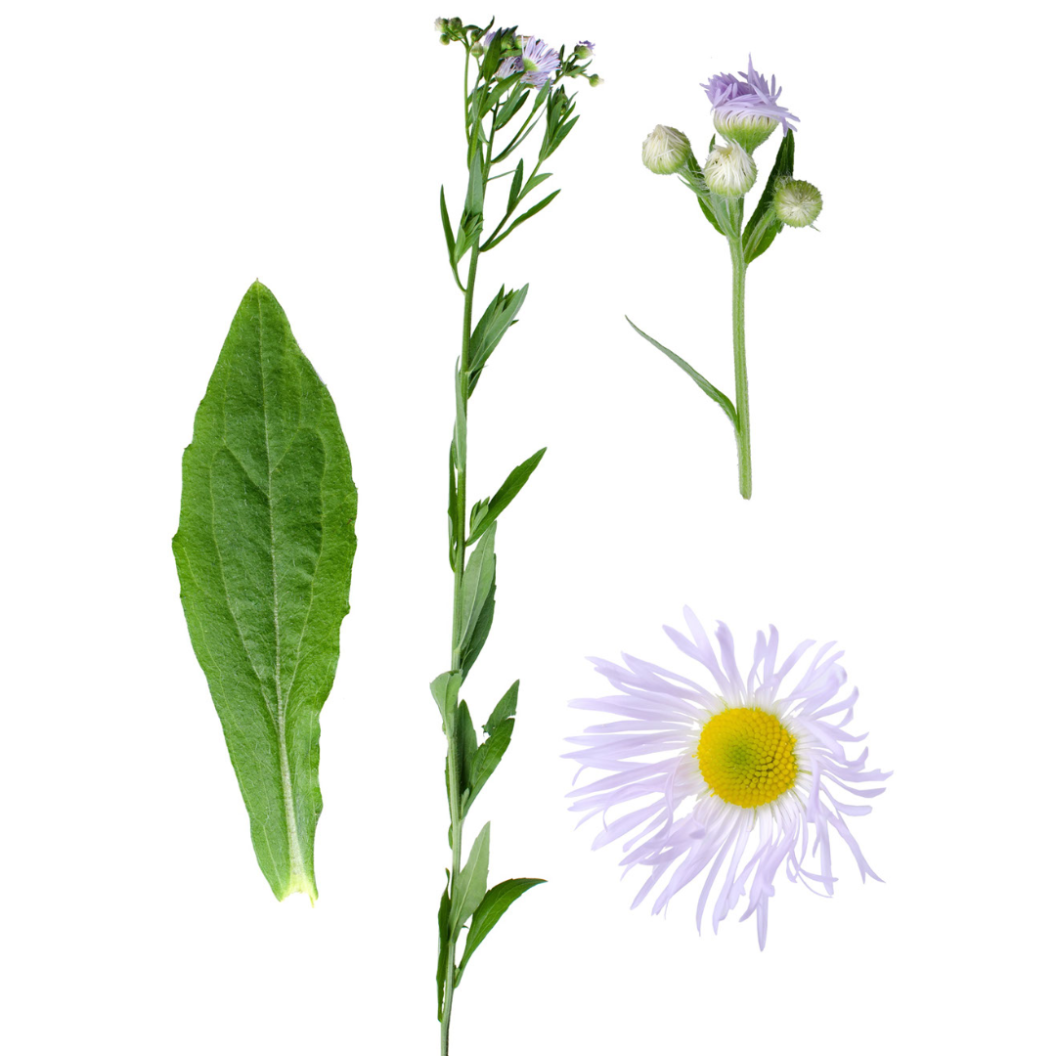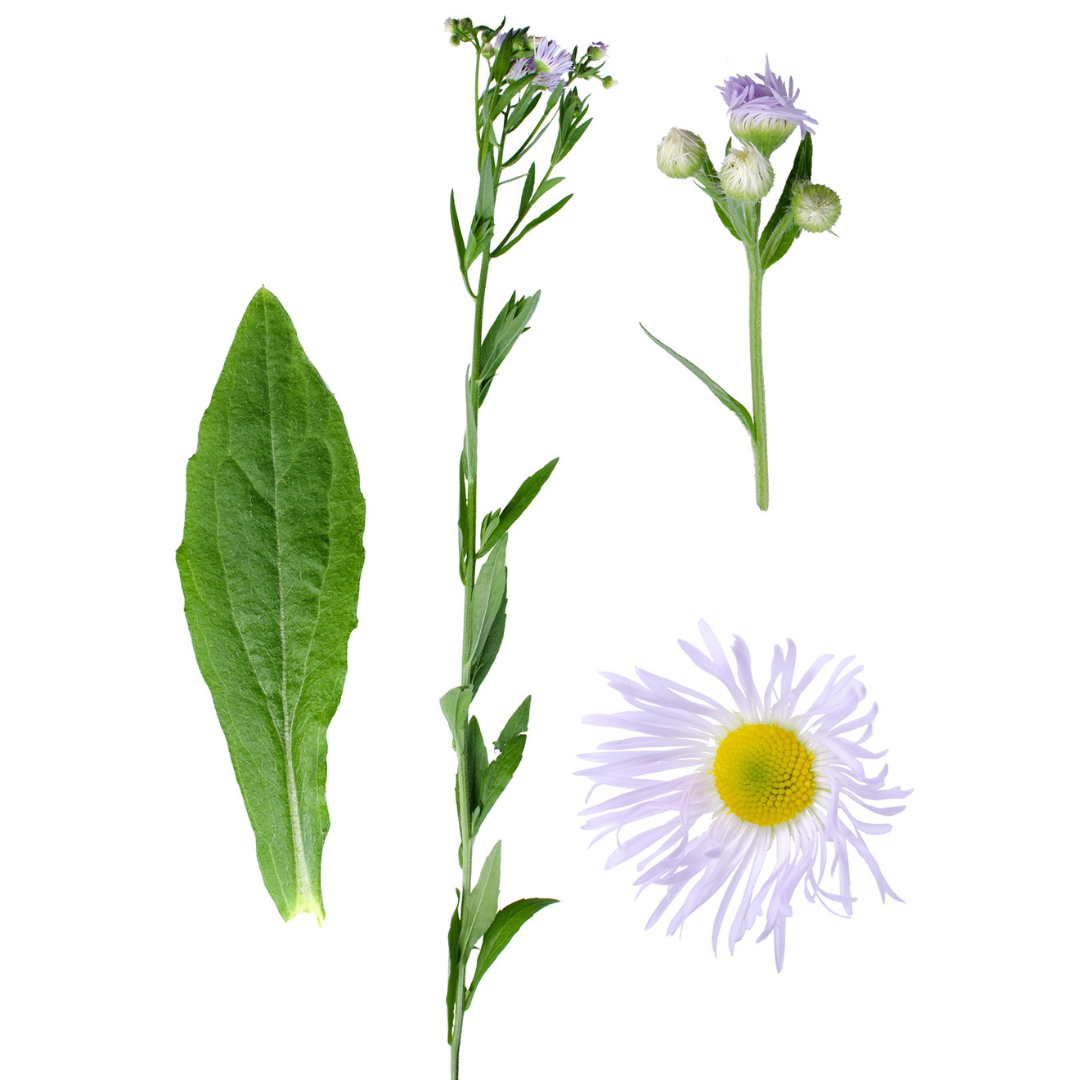
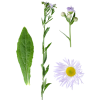
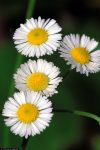

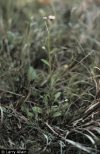
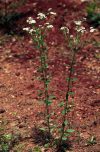
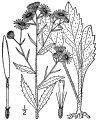
Fleabane
DESCRIPTION: Fleabane is an annual wildflower that looks very similar to a daisy. They can grow up to three feet tall and are often found in open fields, meadows, and along roadsides. They are hardy little flowers that can tolerate a range of temperatures and weather conditions. Many people appreciate the beauty of this plant and its ability to attract pollinators like bees and butterflies.
SCIENTIFIC NAME: Erigeron annuus
OTHER NAMES: Eastern Daisy Fleabane, Sweet Scabious, White Top
LEAF TYPE: Broadleaf
FLOWERS: Fleabane has small, delicate flowers that look like daisies. Each flower has a bright yellow center surrounded by white or light pink petals. The petals are long and narrow, with a slightly ruffled edge that gives the flower a frilly appearance. The flowers grow on long, slender stems that can be up to three feet tall, creating a beautiful, airy display when the plant is in full bloom.
LEAVES: The leaves are long, slender, green in color, and slightly hairy to the touch. They are lance-shaped with a pointed tip and a smooth edge. They grow alternately along the stem. They can be up to three inches long and are arranged in a way that gives the plant a graceful appearance.
LIFE CYCLE: Annual
HOW TO IDENTIFY: Look for a plant with slender stems that is less than three feet tall with small, daisy-like flowers at the top. The flowers will have a bright yellow center surrounded by white or light pink ptals that are slightly ruffled around the edges. The leaves will be green, slightly hair, and lance-shaped. The leaves also may feel slightly rough to the touch.
MECHANICAL CONTROL RECOMMENDATIONS:
1. Hand pulling - More Info
2. Mowing - More Info
3. Tilling - More Info
4. Mulching - More Info
5. Flame Weeding - More Info
6. Mechanical Weeders - More Info
7. Hoeing - More Info
8. Cover Crops - More Info
It's essential to remember that mechanical control alone may not entirely eliminate Poa annua, especially in areas where the grass is actively managed, like golf courses and sports fields. Combining mechanical methods with chemical control and cultural practices can offer more effective long-term management. Always follow best practices and local regulations when using herbicides or pesticides. For large-scale control efforts, it's a good idea to consult with a professional turfgrass manager or horticulturist.
CHEMISTRY RECOMMENDATIONS:
"Pre-emergent herbicides:
Isoxaben: Sold under various brand names, isoxaben is effective against a range of broadleaf weeds, including Erigeron annuus. It can be used in landscapes, gardens, and non-crop areas.
Prodiamine: Prodiamine is commonly used to control grassy and broadleaf weeds, including Erigeron annuus. It can be applied in various settings, such as lawns, turf, and ornamental beds.
Pendimethalin: This pre-emergent herbicide is used to control a wide range of annual grasses and broadleaf weeds, including Erigeron annuus. It can be used in lawns, landscapes, and ornamental plantings.
Dithiopyr: Dithiopyr targets both pre-emergent and early post-emergent control of weeds. It is effective against a variety of grasses and broadleaf weeds, including Erigeron annuus.
Oryzalin: Oryzalin is commonly used to control grasses and broadleaf weeds in turfgrass, ornamental beds, and other non-crop areas. It can be effective against Erigeron annuus.
Benefin: Benefin is another pre-emergent herbicide used to control a range of annual grasses and broadleaf weeds. It can be applied in lawns, landscapes, and other areas.
Trifluralin: Trifluralin is known for its effectiveness against many annual grasses and broadleaf weeds. It can be used in various settings, including ornamental plantings and landscapes.
Post-emergent herbicides:
2,4-D: This herbicide is commonly used to control broadleaf weeds and can be effective against Erigeron annuus. It's used in various settings, including lawns, turf, and non-crop areas.
Dicamba: Dicamba is effective against a wide range of broadleaf weeds, including Erigeron annuus. It's used in lawns, ornamental plantings, and other non-crop areas.
MCPA: MCPA is another herbicide used for controlling broadleaf weeds, and it may be effective against Erigeron annuus. It's used in lawns, turf, and non-crop areas.
Glyphosate: Glyphosate is a non-selective herbicide that can control a wide range of weeds, including Erigeron annuus. It's often used in situations where you want to kill all vegetation, so caution is needed to avoid harming desirable plants.
Triclopyr: Triclopyr is effective against both broadleaf and woody plants. It can be used in areas with Erigeron annuus infestations, especially if other desirable plants are present.
Clopyralid: Clopyralid is known for its selective control of broadleaf weeds, making it a potential option for Erigeron annuus in areas where you want to preserve grasses or other desirable plants.
Carfentrazone-ethyl: This herbicide is often used as a spot treatment for controlling tough broadleaf weeds, including Erigeron annuus. It's useful in lawns, turf, and other non-crop areas.
Sulfentrazone: Sulfentrazone is effective against a range of broadleaf and grassy weeds. It's used in turfgrass, ornamental plantings, and other non-crop areas.
Selective herbicides:
2,4-D: This widely used selective herbicide targets broadleaf weeds and is commonly found in lawn weed control products. It can be effective against Erigeron annuus while sparing grasses.
Dicamba: Dicamba is another selective herbicide that targets broadleaf weeds. It can be useful for controlling Erigeron annuus in lawns, turf, and other areas with grasses.
MCPA: MCPA is a selective herbicide that targets broadleaf weeds. It's often used in lawn care products and can help control Erigeron annuus without harming grasses.
Triclopyr: Triclopyr is effective against many broadleaf weeds and is also used for controlling woody plants. It's an option for areas where Erigeron annuus is present among other desirable plants.
Clopyralid: Clopyralid is known for its selective control of broadleaf weeds. It can be effective against Erigeron annuus while leaving grasses relatively unaffected.
Quinclorac: Quinclorac is a selective herbicide primarily used for controlling broadleaf weeds in turfgrass. It may provide some control over Erigeron annuus in lawn settings.
Fluroxypyr: Fluroxypyr is selective for broadleaf weed control and can be useful against Erigeron annuus without harming grasses.
Carfentrazone-ethyl: While primarily used as a spot treatment, carfentrazone-ethyl can be selective for broadleaf weeds in lawns and turf, including Erigeron annuus.
Sulfentrazone: Sulfentrazone is known for its selective control of broadleaf and grassy weeds. It can be used in lawns and other non-crop areas where Erigeron annuus is present.
Non-Selective herbicides:
Glyphosate: Glyphosate is a widely used non-selective herbicide that effectively kills many types of weeds, including Erigeron annuus. It's commonly used in areas where you want to completely eliminate vegetation, such as preparing an area for planting.
Glufosinate: Glufosinate is another non-selective herbicide that can control a range of weeds, including Erigeron annuus. It's used in similar situations as glyphosate.
Diquat: Diquat is a contact herbicide that acts quickly to desiccate and kill plants on contact. It's used in non-crop areas where complete vegetation removal is desired.
Paraquat: Paraquat is a fast-acting non-selective herbicide that damages plant tissues on contact. It's used to control weeds in various settings, but its use is often restricted due to its toxicity and potential hazards.
Pelargonic Acid: Pelargonic acid-based herbicides work by rapidly disrupting the cell membranes of plants. They are used for quick, non-selective control of weeds, including Erigeron annuus.
Sodium Chlorate: Sodium chlorate is a non-selective herbicide that can be used for total vegetation control. However, it's often considered a more hazardous option and is subject to regulations in some regions.
Recommended Prevention
Recommended Control

